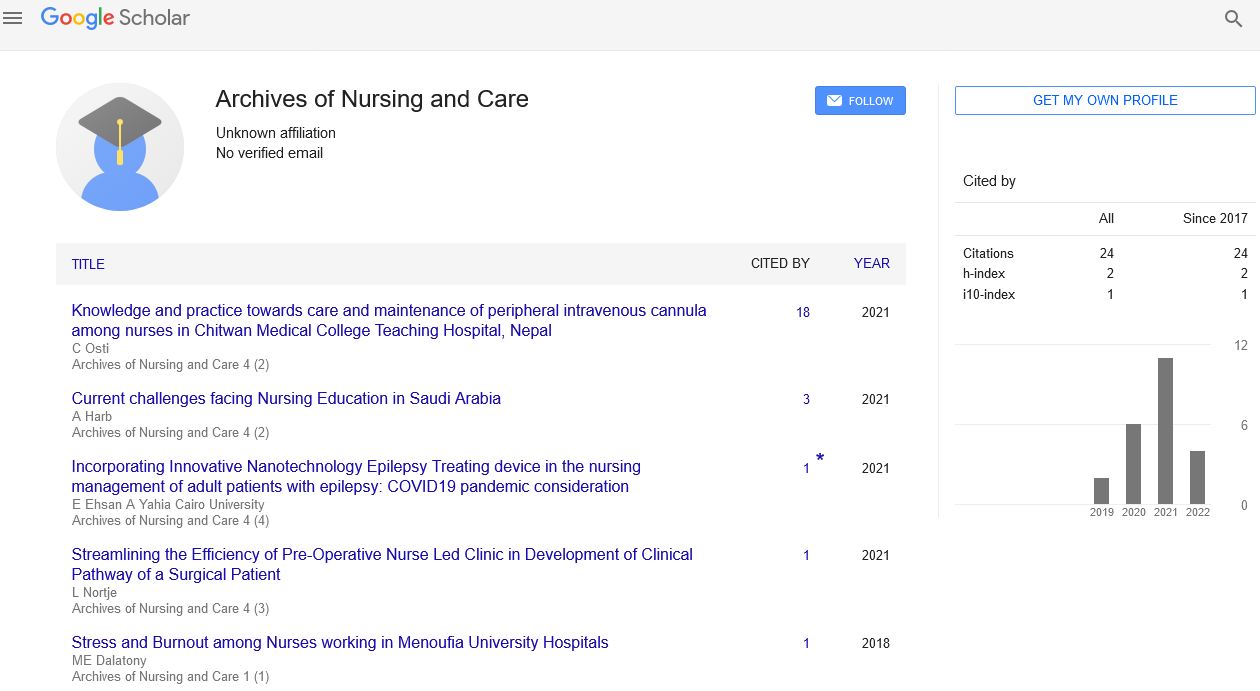Review Article - Archives of Nursing and Care (2023) Volume 6, Issue 1
Family Health Care Nursing
Luke Wolter*
Hanze University of Applied Sciences, Groningen the Netherlands
Hanze University of Applied Sciences, Groningen the Netherlands
E-mail: wolterluke@rediff.com
Received: 02-Jan-2023, Manuscript No. OANC-23-86216; Editor assigned: 04-Jan-2023, PreQC No. OANC-23-86216 (PQ); Reviewed: 18-Jan-2023, QC No. OANC-23- 86216; Revised: 23-Jan-2023, Manuscript No. OANC-23-86216 (R); Published: 30-Jan-2023; DOI: 10.37532/oanc.2023.6(1).001-003
Abstract
The family belief systems hypothesis put forth by Hohashi can be used to facilitate culturally appropriate family health care nursing. The theory of family belief systems, which was developed through family ethnographic studies and questionnaire surveys carried out in the United States, Japan, China, Indonesia, and the Philippines, explains (a) structurization of a system, based on the family members' beliefs as cognition criteria, in which family members' emotions, decisions/acts, and physical responses (including health problems) occur; and (b) the process by which family beliefs are formed from family members' beliefs. The nursing professional can entirely alter the purposeful choices or actions made by the family by identifying the mechanism of family belief systems and supporting the family's or family members' beliefs.
Keywords
CSFET • FBST • Concentric sphere family environment theory • Family belief systems theory • Intentional decisions/acts by the family • Transcultural family health care nursing
Introduction
Concentric sphere family environment theory (CSFET), a middle-range family nursing theory that focuses on the family environment that influences the well-being of the family system unit and can be used in the practise of family health care nursing, was proposed by Hohashi in 2005 for the practise, research, and education of family health care nursing in regions of the world where families exist in a multicultural environment. The family care/caring theory, family belief systems theory, and others have also been suggested as real-world applications of the CSFET. These were created starting in 1999 by target families living in the United States, Japan, China, Indonesia, and the Philippines, and in particular, through family ethnography and questionnaire surveys between urban and rural areas of Japan, macrocultures in the US and Japan, as well as microcultures in single-parent and two-parent homes. They have been created to offer families and specific family members attention that is culturally appropriate [1-5].
Transcultural family health care nursing (TCFN) has been developed in this way. "A knowledge system for practises of care/caring that touch on the family system unit from a cultural perspective," is how TCFN is defined. The CSFET defines culture as "the shared beliefs and values (implicit culture) that enable members of a group or organisation to adapt to their environment, and the patterns of behaviour (explicit culture) that are regulated by them." A culture rich in diversity is created as a result of the interaction/transaction between people's actions and the environment.
Family rules and beliefs are included in the functional questions used for family assessment in the CSFET (Version 3.0), which show how a family's beliefs affect its well-being. The FBST is a mid-range family nursing theory that sits between the CSFET and family care/caring, focused on the family/family member beliefs that govern the family system unit's purposeful decisions/acts [6-8].
The FBST is used in this article to explain (a) a system that bases family members' emotions, decisions/acts, and physical reactions (including health problems) on their beliefs as cognition criteria; and (b) the process by which family beliefs are formed from family members' beliefs by which intentional decisions/acts by the family are performed. It also presents evidence in support of family/family member beliefs, enabling the family to carry out deliberate activities (family decision making, family self-management, upkeep and enhancement of family wellbeing, etc.) with consensus and agreement. The FBST is intended to be improved upon and made more widely known as a fundamental theory for defining and comprehending family culture.
Encouragement of family and family members' beliefs using the FBST
Humans are not harmed by the event that happened to a family member; rather, they are harmed by the feelings that result from evaluative cognition about the incident. The family member's evaluative cognition, emotions, decisions/acts, and physical responses can all be modified by altering the beliefs that govern this evaluative cognition. Additionally, all family members share the underlying ideas that underlie the family signs and symptoms in the targeted family. The family is able to make deliberate judgements and take actions that result in pleasure and agreement thanks to changes in family beliefs, event moderators, cognition moderators, or family member's views influencing variable/ constant.
When offering support for family/family member views, there may be a contradiction between the targeted family's beliefs regarding a family/family member event and the nursing professional's beliefs about the same family/ family member. In such a situation, it is feasible that the nursing professional's beliefs about the family or family member may have an impact on the support for those beliefs. The nursing practitioner is better able to support the targeted family in a way that respects the family's beliefs by having knowledge about beliefs.
A family evaluation model, the family environment assessment model, as well as a family intervention model, the family environment care/caring model, are also available and are based on the CSFET. FECCM includes support for family/family members' beliefs based on the FBST [9-10].
Indirect encouragement of family members' beliefs
First among events, the event moderator, cognition moderator, and family member's beliefs influencing variable/constant that are the cause of family signs/symptoms are identified as those that can be changed for the indirect support for family/family members' beliefs. These make up the family environment/family unit system, and the family environment arrangement is mostly applicable to the indirect support for family/ family members' ideas. In other words, the family member's emotions, decisions/acts, and physical reactions can be changed, as well as the decisions/acts of the family, by altering or eliminating the events that occur and arranging the event moderator and cognition moderator. Additionally, family/family member beliefs can be altered by organising the variables and constants impacting those beliefs.
Conclusion
In the CSFET and FBST, culture is described as "the ideas and values (implicit culture) shared by members of a group or organisation to enable adaptation to their environment, and the patterns of acts (explicit culture) that are regulated by them." Culture has been defined in a variety of ways. For instance, both the patient and the nursing staff have unique and separate cultures. Even within the same family, for instance, a married couple, the husband and wife may come from diverse cultural backgrounds. According to the FBST, which focuses on these kinds of microculture, a system can be structured in which feelings, decisions/acts, and physical reactions (including health issues) arise as explicit culture depending on the family member's views as implicit culture as cognitive criterion. The family is the setting in which these individuals congregate. For instance, a certain family and a nearby family each have their own unique cultures. The FBST focuses on the organisational culture of the family and can explain how family beliefs are created from the beliefs of family members as implicit culture and how intentional family decisions and acts (such as family decision making, family self-management, etc.) are carried out as explicit culture. Nursing professionals can use the theory when dealing with family/family members, in situations like the hospitalisation of a sick family member, as it was said in the section on "Determining Positive Family/ family Member's Beliefs and Negative Family/ family Member's Beliefs." Furthermore, the FBST is a middle-range family nursing theory that has been focusing on more than 900 families in the United States, Japan, China, Indonesia, and the Philippines since it was founded in 1999 on the basis of family ethnography. This suggests that the FBST can be used in nursing research and practise in nations and areas with various macrocultures. The FBST is essential for achieving culturally appropriate care/caring for individuals and families, which is the cornerstone of diversified macroculture. The nursing professional has the power to significantly alter the difficulties, issues, and challenges that affect families and family members by figuring out how a family belief system works and by promoting that belief.
References
- Happell B, Gaskin CJ. The attitudes of undergraduate nursing students towards mental health nursing: A systematic review. Journal of clinical nursing. 22, 148-158 (2013).
- Edwards D, Burnard P, Coyle D, et al. Stress and burnout in community mental health nursing: a review of the literature. Journal of psychiatric and mental health nursing. 7, 7-14 (2000).
- Ward L. Mental health nursing and stress: Maintaining balance. International journal of mental health nursing. 20, 77-85 (2011).
- Brown AM. Simulation in undergraduate mental health nursing education: A literature review. Clinical Simulation in Nursing. 11, 445-449 (2015).
- Barker P, Buchanan‐Barker P. Myth of mental health nursing and the challenge of recovery. International Journal of Mental Health Nursing. 20, 337-344 (2011).
- Mann S, Cowburn J. Emotional labour and stress within mental health nursing. Journal of psychiatric and mental health nursing. 12, 154-162 (2005).
- Kipping CJ. Stress in mental health nursing. International Journal of Nursing Studies. 37, 207-218 (2000).
- Mårtensson G, Jacobsson JW, Engström M. Mental health nursing staff's attitudes towards mental illness: an analysis of related factors. Journal of psychiatric and mental health nursing. 21, 782-788 (2014).
- Cleary M. The realities of mental health nursing in acute inpatient environments. International journal of mental health nursing. 13, 53-60 (2004).
- Foster K, Roche M, Delgado C et al. Resilience and mental health nursing: An integrative review of international literature. International journal of mental health nursing. 28, 71-85 (2019).
Indexed at, Google Scholar, Crossref
Indexed at, Google Scholar, Crossref
Indexed at, Google Scholar, Crossref
Indexed at, Google Scholar, Crossref
Indexed at, Google Scholar, Crossref
Indexed at, Google Scholar, Crossref
Indexed at, Google Scholar, Crossref
Indexed at, Google Scholar, Crossref
Indexed at, Google Scholar, Crossref

